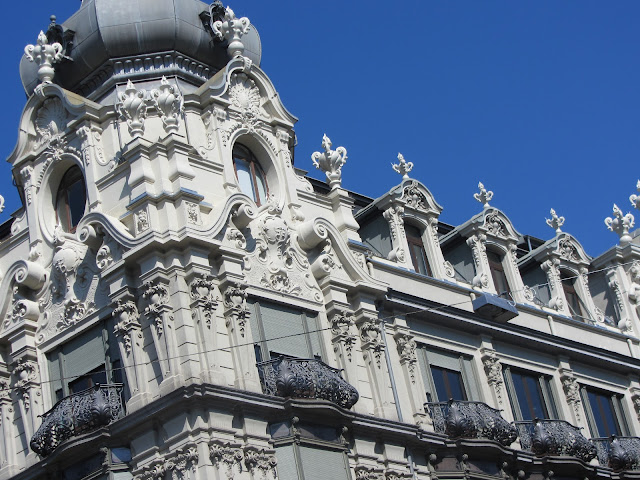My brief foray in to Zurich in the dusk of my arrival day convinced me that the Old Town was the place to start my explorations on my first full day.
I has some guidance from the excellent ZuriPlan iPad app but mostly it was a question of heading down any road that looked interesting.
My hotel, the St Gotthard, is on the edge of the old town and a very short walk takes you off the main shopping street, the almost relentlessly ugly Bahnhofstrasse that is packed with international chain stores, and in among pretty buildings carrying the beauty of cared-for age.
This is a proper old town with small lanes curving and dividing in all directions so it is easy to get lost in a nice way. These lanes are full of boutique shops, expensive restaurants and boundless character.
Decorations are everywhere.
Whenever lanes meet the excuse to create a little space is taken and in that space is a drinking fountain with a statue.
Fresco's are common too. My German is nothing like good enough to work out what they are all about but some are clearly a description of what does, or once did, go on inside the building while others are a mystery to me.
Whatever their purpose they all add to the rich character of the area.
There are two ways to the river from here, round the hill or over it. That is not much of a choice really as going over the hill takes you to Lindehof, a park with space to play or just to sit and look over the river to the east side of the town. The cobbled lanes leading there have steps cut in to the side in recognition of how steep the climb is, albeit a short one.
Two adjacent churches battle for attention their weapons of choice being their clock faces.
St Peterskirche claims the largest clock faces in Europe, which is impressive, but I prefer the smaller and more elegant Fraumunster that lies just short distance to the south.
Both towers are visible from most of the high vantage points around the city, and there are many of these, and it is the Gothic frivolity of Fraumunster that is the more distinctive.
Continuing south for the moment, towards the lake, takes you out of the old town and in to the financial district. The wealth here is obvious not least from the size and flamboyance of some of the buildings. The Baroque style is not that common in Zurich but when it does appear it is with characteristic Zurich brashness.
There is a bridge, Quaibrucke, that takes you from from the financial district on the north side of the lake to the east side of the town and this is heavily used by cars and trams.
So I headed north along the river a little to Munsterbruke (next to Fraumunster unsurprisingly) which offers this view of the other bank. That is the Rathaus on the left.
Crossing the bridge takes you directly to the Cathedral. Photography is not allowed inside so you will just have to take my word for it that the stained glass is worth seeing. Incidentally I obey the no photography rule in churches and shops where it has a point and am equally happy to ignore the same rule in theatres where it is pointless.
The Cathedral has two towers and unfortunately you are allowed to climb one of them. Standing on precarious ledges at great height is hardly my favourite pastime but sometimes you have to do that to get the views.
Bravely looking down to the north shows both sides of the river and how the Rathaus is built above it. The Rathausbrucke is the widest of the many bridges across the Limmat and there is space for a small carousel with its blue and white roof (the colours of Zurich) and also for some market stall beyond.
The buildings on both banks face each other aggressively as if only the water keeps them from fighting to prove which side really is the best side of Zurich.
Looking back to the west bank and the view is dominated by St Peterskirche (Fraumunster is just to the left of the picture and has already had its time in the spotlight).
The higgledy-piggledy nature of the roof-scape is evidence of the confusing pattern with which the buildings are spread over the ground.
The variation in height of the buildings does something to mask the variation in height of the ground that rises quite steeply from left to right.
Leaving the Cathedral and heading west again takes you up another hill and in to another nest of lanes. Random turns took me first to Neumarkt and then along the narrow passage Predigergasse towards another church with this extraordinary sundial facing directly towards you.
I did and saw quite a lot more that day, including the old barracks,fountains in the lake, green bicycles, classical and modern sculptures, floating flowers, remains of a Roman bath, battalions of sunbathers and swimmers, swans and a house Lenin once lived in; all of which helps to explain how I managed to take 184 photographs.
9 September 2012
Subscribe to:
Post Comments (Atom)














No comments:
Post a Comment
All comments are welcome. Comments are moderated only to keep out the spammers and all valid comments are published, even those that I disagree with!